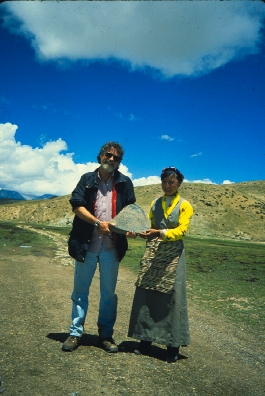Chinese government to confer Friendship Award on Cornell geophysicist Larry Brown for seismological study of Himalaya region
By Roger Segelken

Larry D. Brown, professor of earth and atmospheric sciences at Cornell University, will receive the Chinese government's 2001 Friendship Award during celebrations of the 52nd anniversary of the founding of the People's Republic of China, Sept. 27-Oct. 2.
The award, which is conferred through China's State Administration of Foreign Experts Affairs, honors Brown for his geophysics work in Project INDEPTH (International Deep Profiling of Tibet and the Himalaya). Under way since 1990, the Project is an interdisciplinary program of geophysical and geological studies to develop a better understanding of the deep structure and mechanics of the Himalaya-Tibet region.
Working in a region where two continents have collided to form the world's highest terrain, more than a dozen institutions in the United States, Canada and Germany are collaborating with the Chinese Academy of Geological Sciences of the Ministry of the Interior (formerly Ministry of Geology and Mineral Resources). Research funding for the project is provided by Ministry of the Interior, the Continental Dynamics Program of the U.S. National Science Foundation, the Chinese National Natural Science Foundation, the Deutsche Forschungsgemeinschaft and the GeoForschungsZentrum Potsdam. Brown was one of the founding scientists of the project, along with professors Douglas Nelson of Syracuse University and John Kuo of Columbia University. Brown currently serves as one of the principal investigators for the project, and, he says, the Chinese government's award rightfully should be shared with all the project leaders.
Project INDEPTH's field work began in 1992 with a test of multichannel deep seismic profiling, using explosive sources, in the Himalaya of southern Tibet. That test succeeded in identifying and tracing the principal fault, known as the Main Himalaya Thrust, where the Indian crust is underthrusting deep beneath the Himalaya. In 1994-95, the project conducted a second field program of expanded active and passive seismic surveys, geological field mapping and magnetotelluric soundings from the Himalaya across the Zangbo suture and into the Tibet Plateau. At a depth of 15-18 kilometers
beneath the southern plateau, the project detected "bright spots" of active magma accumulations. The extensive presence of fluids in the upper-middle crust in that region is now believed to result from partial melting due to crustal thickening and extension.
Moving its research to the central portion of the TibetPlateau in 1998-99, the project has found evidence to indicate that melt is widespread in the deep crust in Tibet. Moreover, the new findings include support for the hypothesis that a part of the Indian continental lithosphere was thrust beneath the southern half of the plateau and evidence for a deep "graveyard" for the ocean that once separated the Indian and Asian continents.
Brown joined the faculty of Cornell's Department of Geological Sciences, now the Department of Earth and Environmental Sciences in the College of Engineering, in 1977 and teaches classes on earthquakes and exploration geophysics. He is a specialist in seismic reflection profiling, a technique that depicts features of the Earth's deep crust by sending seismic waves from controlled explosions and vibrating machines, then recording the reflected waves as they return to the surface. Recently Brown has also used ground penetrating radar (GPR), a technique similar to reflection profiling, to explore the shallow subsurface. Recent GPR investigations include mapping of buried Mayan features in Honduras with noted Cornell Mayan archaeologist John Henderson, investigation of groundwater resources on Cozumel, Mexico, and aiding the search for mastodon remains in New York state.
Together with graduate and undergraduate students and scientific colleagues, Brown has conducted seismic reflection surveys across three continents. Among his current initiatives are deep seismic surveys proposed for Nepal, Japan, Taiwan, Mexico, East Africa and Madagascar. At Cornell, he is also the director of graduate studies for the Field of Geological Sciences.
Media Contact
Get Cornell news delivered right to your inbox.
Subscribe